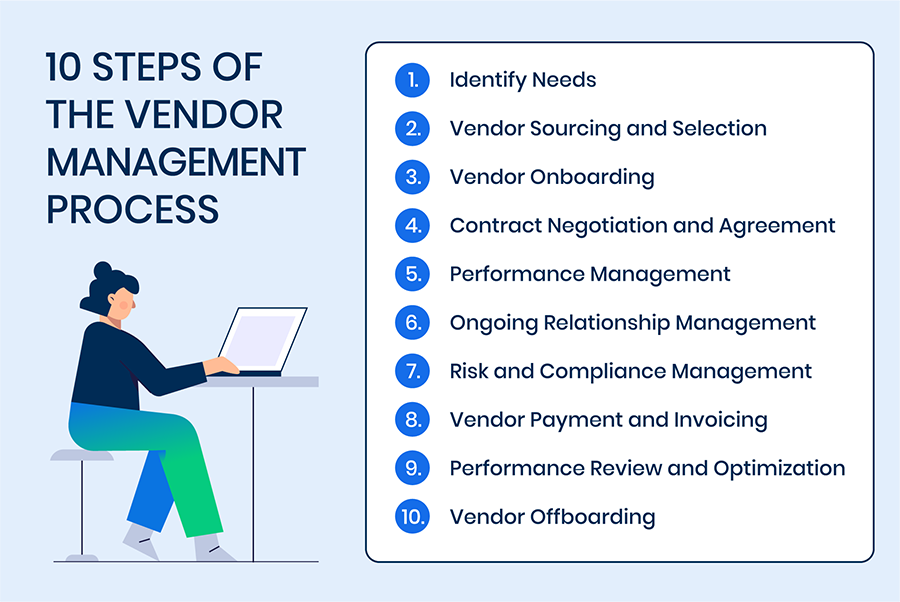For most businesses, vendors play a huge role in keeping operations running smoothly. Whether sourcing materials, handling logistics, or providing specialized services, vendors allow companies to stay focused on their core strengths while relying on external expertise for other needs.
As companies team up with third-party suppliers to boost efficiency and bring fresh ideas to the table, managing these vendor relationships has become more important than ever.
Companies that excel at vendor management stand out from the rest. They build dependable partnerships, resulting in more reliable supply chains, streamlined operations, and increased customer satisfaction.
In today’s guide, we’ll cover the full scope of vendor management—from selecting and evaluating vendors to building long-term relationships, setting clear performance goals, and managing risks along the way.
Let’s start with some basics.
What Is Vendor Management?
Vendor management is the strategy and process a company uses to work with its suppliers in an organized, efficient, and mutually beneficial way.
Vendors can include any external provider a business relies on to operate smoothly—such as manufacturers, logistics providers, technology providers, consultants, or service providers. The primary goals of vendor management are to ensure a stable supply chain, the timely and quality delivery of products or services, effective cost management, and minimized risks.
Effective vendor management isn’t just about responding to issues as they arise; it’s also about fostering long-term, mutually beneficial relationships. When companies and their vendors collaborate openly, they’re more likely to innovate together, find cost savings, and improve products or services.
Strong vendor relationships can lead to priority treatment during peak times, early access to new products, or more favorable pricing. In this way, vendor management becomes a strategic asset rather than just an administrative task.
10 Steps Of the Vendor Management Process
For many companies, managing vendors goes beyond simply choosing suppliers and hoping for the best. It involves a structured approach that includes clear communication, ongoing performance checks, and strong relationship-building efforts.

Here are 10 key steps to guide your vendor management process:
Step 1: Identify Needs
Start by identifying what your business needs from vendors. This could include specific materials, services, or expertise that will support your goals.
Once you’ve clarified these needs, list out the qualifications and requirements for an ideal vendor—such as reliability, cost, experience, or delivery speed. Prioritize these requirements to focus on what matters most, helping you find the right vendors to meet your objectives.
Step 2: Vendor Selection
Begin searching for potential vendors by researching the market, issuing requests for proposals (RFPs), and seeking referrals.
Create a shortlist and evaluate each vendor carefully, considering factors like experience, reputation, and financial stability. Think about how well they align with your company’s culture and values. And if needed, arrange interviews or site visits to gain a deeper understanding of each vendor’s operations and assess fit.
Step 3: Vendor Onboarding
Once you’ve selected a vendor, start the onboarding process by setting up any necessary systems or workflows to integrate them into your company’s operations.
Establish clear roles, responsibilities, and expectations for both parties. This might involve educating the vendor on your company’s procedures, industry norms, or compliance requirements. Set up regular communication channels and contact points to keep the relationship organized and ensure alignment.
Step 4: Contract Negotiation and Agreement
Define the terms and conditions of the partnership, including the scope of work, pricing, deadlines, and quality standards. Specify how performance will be measured and outline any compliance or legal requirements.
Negotiate final terms with the vendor to ensure both parties are protected and satisfied with the arrangement. Review the contract thoroughly and finalize the agreement once both sides agree on the terms.
Step 5: Performance Management
Establish key performance indicators (KPIs) to track the vendor’s performance in areas like quality, delivery, cost, and customer satisfaction.
Monitor their performance regularly through scheduled reviews and data analysis. Feedback from your team and stakeholders can also offer valuable insights into the vendor’s performance.
Step 6: Ongoing Relationship Management
Maintain an open, collaborative relationship with your vendor by staying in regular communication. Share updates, answer questions, and work together to resolve issues quickly.
Treating the relationship as a partnership fosters trust and cooperation, which makes problem-solving easier and often leads to better outcomes.
Step 7: Risk and Compliance Management
Each vendor relationship comes with its own risks, such as supply chain disruptions or quality issues. Identify potential risks associated with each vendor and develop plans to manage them.
Ensure that vendors meet all regulatory and industry compliance standards, and periodically review these to stay up-to-date. Contingency plans, such as having backup suppliers or extra inventory, help ensure business continuity in the event of disruptions.
Step 8: Vendor Payment and Invoicing
Streamline your payment and invoicing process to avoid delays or miscommunications. Use consistent payment schedules and verify invoices to ensure they match contract terms.
Automation tools like accounts payable (AP) automation can speed up this process and reduce errors. Maintaining clear financial records of all transactions also assists with tracking spending and budgeting for future vendor relationships.
Step 9: Performance Review
At the end of the contract or periodically throughout the year, conduct a comprehensive performance review of the vendor’s work.
Evaluate whether they met their KPIs and delivered value according to the contract. This is a good time to identify areas for improvement or to consider adjustments to the contract terms. Assess whether the cost of working with the vendor aligns with the value they provide, and decide if renewing or renegotiating the contract is beneficial.
Step 10: Vendor Offboarding
When it’s time to end a vendor relationship, plan for a smooth transition. Notify the vendor in advance and confirm that all necessary documents and resources are returned.
An exit interview with the vendor can provide valuable feedback to help refine your vendor management process. Update your records with details about the vendor’s performance and the reason for ending the relationship, which can serve as a reference for future vendor decisions.
Best Practices for a Successful Vendor Management
- Align vendors with company values and culture
Select vendors whose values and work culture closely align with your own. Having this alignment can improve communication and strengthen mutual understanding, leading to more effective collaboration.
- Encourage vendors to bring ideas and innovations
Invite vendors to suggest improvements or innovations. Many vendors work with multiple clients and can offer valuable outside perspectives that lead to efficiency gains or product enhancements.
- Use technology to support vendor management
Utilize vendor management software or digital platforms to streamline tasks such as contract management, data collection, and performance monitoring. Technology can make the vendor management process more efficient and transparent.
- Standardize key processes for consistency
Develop standard operating procedures for tasks like vendor selection, contract negotiations, and performance reviews. Standardizing these processes improves consistency and makes it easier to manage multiple vendors and vendor master file effectively.
- Recognize and reward high-performing vendors
Implement a rewards system for vendors who consistently meet or exceed expectations. Recognizing good performance fosters a positive relationship and motivates vendors to continue delivering exceptional results.
- Build contingency plans with vendor input
Involve key vendors in contingency planning, especially for critical supplies or services. Understanding their constraints and resources can lead to more realistic and reliable backup plans.
- Collaborate on cost-saving initiatives
Work with vendors to explore cost-saving opportunities, such as bulk purchasing, optimized shipping methods, or process improvements. Collaborative cost management can create savings for both parties without compromising quality.
- Focus on data security and confidentiality
Ensure strong data security practices, especially with vendors handling sensitive information. Confirm that vendors adhere to robust data protection policies and understand your company’s security standards.
- Use benchmarks to evaluate performance
Compare vendor performance metrics against industry benchmarks to provide context for evaluating performance. This can highlight areas where vendors excel or need improvement.
- Involve cross-functional teams in vendor decisions
Include representatives from multiple departments (e.g., finance, operations, legal) in vendor selection and management decisions. This approach ensures diverse perspectives and a comprehensive evaluation of each vendor’s impact on the business.
- Monitor market conditions for potential vendor risks
Stay informed about market trends and conditions that might impact vendor performance, such as raw material shortages or regulatory changes. Proactive awareness allows you to address risks and adjust vendor strategies as needed.






